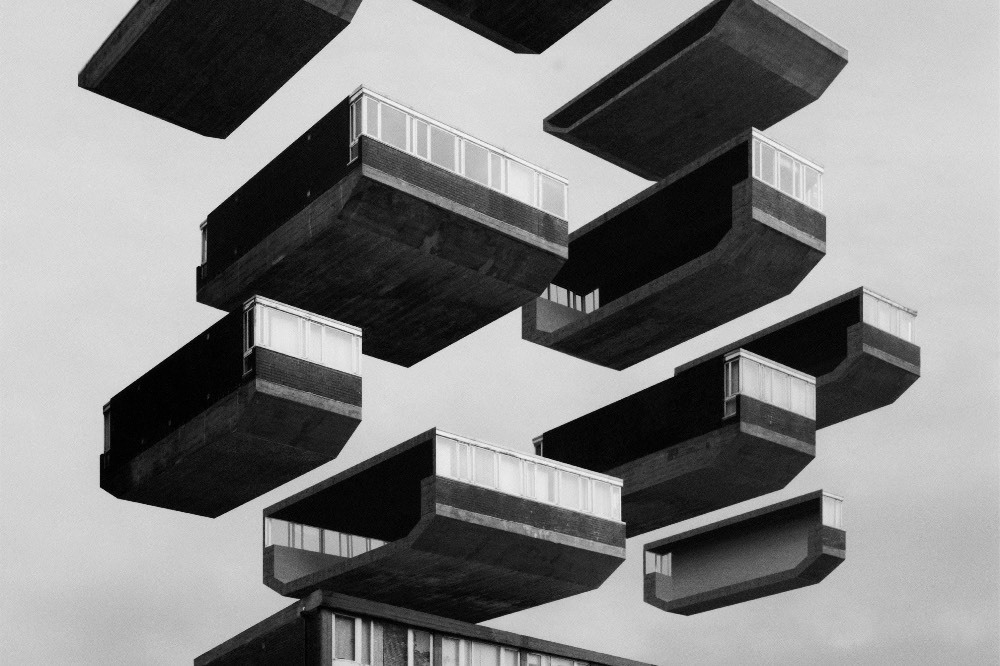The charged emptiness of these prints is underlined by their lack of the very yardstick for works of architecture, namely the human figure. For modernist architecture, admittedly, this was often a purely mathematical figure, such as Le Corbusier’s concept of the Modulor, constructed as a universal system of proportions – equal parts mathematics, anatomy, and aesthetics – that could serve as a template for everything from door knobs to entire urban structures. There is nevertheless a paradoxical fear of living inherent in some modernist architecture. Perhaps the humanity that is reflected in its interface is humanity as a machine, with its needs mapped out and projected on rows of ribbon windows. “Architecture is always dream and function, expression of a utopia and instrument of a convenience,” as Roland Barthes writes in The Eiffel Tower and Other Mythologies.
As a futuristic idea this concept belongs to an era when the future was still viewed as something positive and better, and the hubris of modernity is perhaps to blame for the fact that much of the iconic brutalist architecture of the post war era has today been greatly popularized through various image-sharing media. These works are comforting ruins – or urban veterans, if you will – from the fragile fundament of cultural history that underpins our current civilizational project. Offering an updated look at this legacy, Dietrichson’s pictures have liberated themselves both from the nostalgia of run-of-the-mill ruin pornography and from the more classical and oftentimes dystopian melancholy associated with urban images.
In these silkscreen series, which disconnect architecture from the form of the mathematical human, the introverted face of modernity becomes something more expressive and exalted. The selection of images, and the minutious variations on display in the various series, speak above all to a sculptural interest – to the variance between the restrained and the boundless, between dream and function, between the generic and the specific, between repetition and difference. There is something demonstrative about such a dissection that brings to mind Gordon Matta-Clark’s conceptual interventions from the 1970s, where entire buildings might be divided in two. Instead of being a witness of time, photography thereby becomes a sculptural intervention that manages to destabilize fixed reference points such as gravity and scale.
The artist has himself referred to these works as collages. At the same time, it is the technical precision in the series’ manipulations of photographic material that gather the surface’s collapsing of time in a new illusion of space and in a new narrative about the urban landscape. Through this unassuming demonstration of something impossible alongside its very realization, Dietrichson’s works place themselves somewhere between planning and documentation, between drawing and photography, between process and imprint. Given how clearly grounded the images are in modernist architecture, one could easily read them as a well-intended elbow jab at the religious cultivation of the media-specific in modern art history. At the same time, Dietrichson’s demonstrative hybrids reflect an unmistakably digital concept of images, where the simulation of space has come ever more to influence how we navigate our surroundings. In the pictorial universe of 3D modelling, the perspective is as a rule logical while the scale ratio is flexible. We are thereby relegated to navigating more and more in visualized and mental spaces, which we to an increasing degree project instead of experience with our bodies. The fundamental reorganization of proximity and distance that modernist architecture represents achieves a new height in an everyday world structured by screens and smart technology. Dietrichson’s silkscreens insist that this urban experience still retains something magical and haunted about it, like an interface between people and technology, meticulously engraved in stone.
Maria Moseng
(from the book Espen Dietrichson – Seven Years, 2018)




